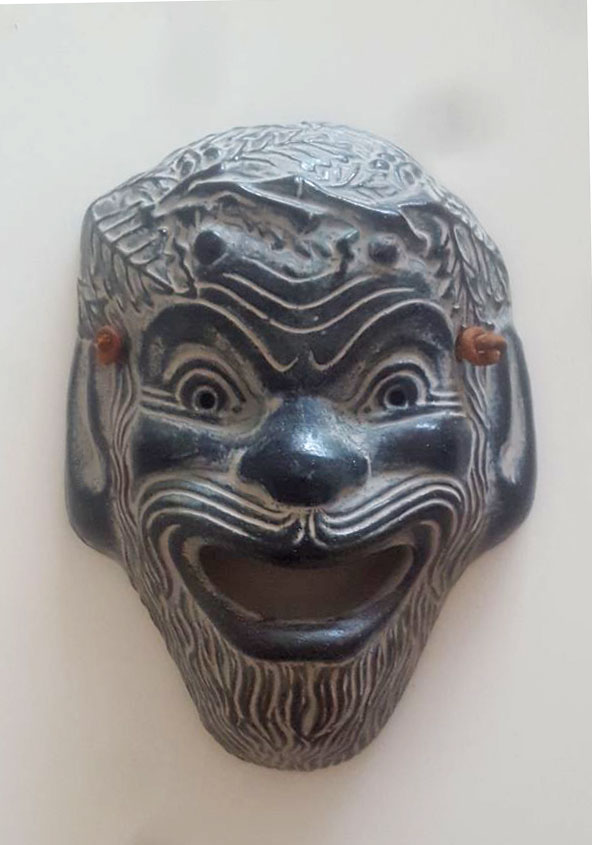 Q: If possible I would like to know more about this mask. I bought it at a yard sale for next to nothing. It’s not a mask I can identify anything about, so any information would be appreciated. Specifically interested in what culture, location or time frame it comes from and if it is a recent replica, what style it is based on. Leander, 1421 Q: If possible I would like to know more about this mask. I bought it at a yard sale for next to nothing. It’s not a mask I can identify anything about, so any information would be appreciated. Specifically interested in what culture, location or time frame it comes from and if it is a recent replica, what style it is based on. Leander, 1421
A: The inspiration for our little souvenir is a Gigaku mask that was used in 8th century Japan with music and dance for the upper classes. This scaled-down copy was probably made 2000 years later as an inexpensive piece of wall decor. C
And now, a very brief but thorough history of Japanese masks I found on the internet…
Gigaku masks are the oldest masks, used in dance drama art form, but this dance art form doesn’t exist today. They represented a face of superhuman, demon, lion, bird and were made from wood.
Bugaku masks are old masks of dance drama art form. They had moveable jaws.
Gyodo mask represents Buddhist figures. It is used for outdoor Buddhist processions.
Tengu mask represents bird-like protector of sacred forests and mountains. It looks like a human with a big nose.
Kappa mask represents river monster that can attack swimmers. This creature can challenge a man to sumo wrestling match.
Noh is classical Japanese musical drama based on tales from traditional literature. The actors tell a story through gestures and appearance in masks. They capture the essence of the story. The Hannya mask, best known Noh mask, represents jealous female demon in noh and kyōgen Japanese traditional theater plays and Shinto Kagura ritual dances. The mask has a learing mouth, sharp teeth, metallic eyes and two sharp devil-like horns. The expression of Hannya mask is at the same time demonic, frightening, dangerous and tormented, sad, angry, heartbreaking, sorrowful and melancholic. Hannya appear as normal female, but when she is betrayed, get angry and jealous she turns into a demon.
Kyōgen is a form of traditional Japanese comic performance in the theater. It was performed as an intermission between Noh acts.
Shinto is an ethnic religion in Japan, and it focuses on ritual practices. Kagura is a type of Shinto theatrical dance, and it consists of ritual dances in villages in a harvest festival. One of the dances is lion dance that represents mimic and movement of a lion in a lion costume. It consists of a wooden head. The whole costume, including mask, can be manipulated by one or two persons. The mask can have horns to look like a beast.
Kitsune mask is a mask of a fox. In Japanese culture, Fox has contradictory behavior. It can be benevolent (good) or malevolent (evil) depending on the situation. In Shinto religion, Fox is a messenger of the god Inari, who is the protector of rice, agriculture, and fertility. Fox brings rich harvest, and it is a symbol of wealth.
Hyottoko mask represents a lucky mythical spirit with a clown-like funny face. Okame is the female version and represents goddess who spreads good fortune.
Oni mask represents demon with comical or fearsome expression. This creature is easy to scare away.
Kabuki is modern theater art form. Classical masks are replaced by painted faces and make-up. This form uses all kind of techniques, like actors attached to wires and “fly”, upward or downward moving part of sets and revolving stage. Rice powder is used to create a white base for make-up. Make-up is used to exaggerate and enhance facial lines. Purple lines represent nobility. Green lines represent supernatural. Red lines represent passion, hedonism, and other positive things. Blue or black lines represents jealousy, villainy, and other negative things.
In ancient Japan, Samurai was a warrior who protected nobility. Samurai mask was added to the armor to protect head and face of samurai and to strike terror into the enemies. These masks were custom made to reflect the personality of each samurai.
Kendo mask is attached to the shoulder and throat armor. Kendo is a martial art of sword fighting with bamboo swords.
Animegao masks represent manga and anime characters. |


 Hermit mask from Michoacan
Hermit mask from Michoacan
2 Comments
John Burness
this is a copy of an ancient greek theatre mask,in no way or form is it japanese.
John
Its not Japanese, its greek, its a Satyr. Probably woth something around 50 to 100 dollars.